Welcome back to Too Much Information, Legacy. We had to take a bit of a break from writing these articles, so we apologize to all of our fellow number crunchers who have been aching for Legacy statistics. To satiate those appetites, and to fully catch up in preparation for Atlanta, we’ll be looking at a full four tournaments at once—Seattle, Pittsburgh, Richmond, and Boston. The spreadsheet for all of them is available here.
The Legacy metagame has shown some significant shifts across these four events, some of which are more surprising than others. We’ll jump right into it with the breakdown from Seattle, which took place more than a month ago, now:
Seattle Legacy Open Breakdown
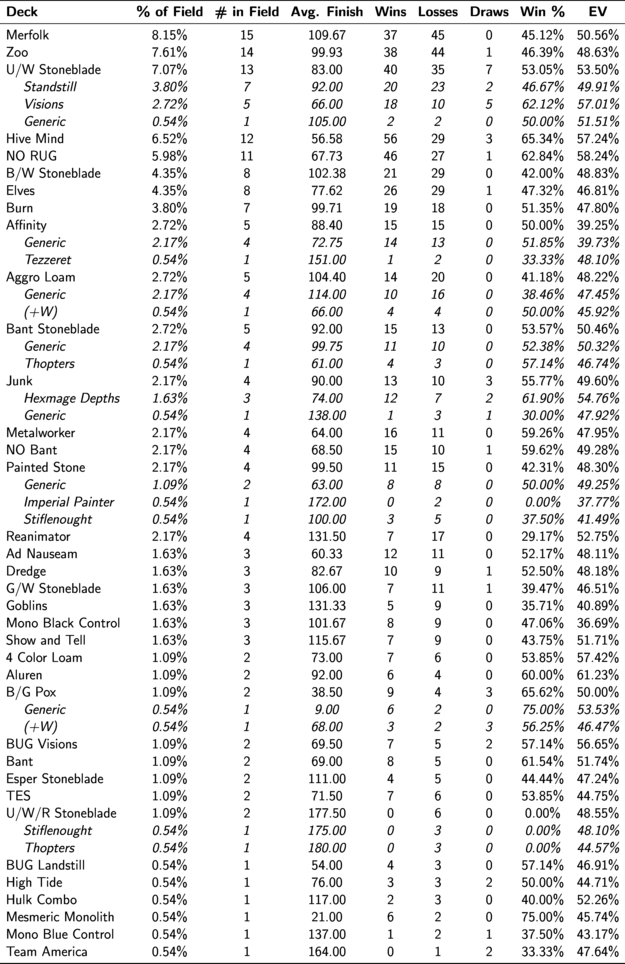
Right away, we can see that this field was incredibly diverse, even for Legacy, with a very even distribution of players among decks. In fact, each of the five most-popular decks was just a single player ahead of, or behind the next. The top three decks were just what we’ve come to expect: Merfolk, Zoo, and U/W Stoneblade.
Merfolk would usually be further ahead of the rest; its popularity was particularly low in Seattle (the lowest it’s been since well before New Phyrexia). The deck’s win percentage was very poor, as it was in Cincinnati.
Zoo fared similarly poorly and showed a below-even EV as well.
U/W Stoneblade was the most popular deck to post a winning record, and had the EV to match.
The story of the weekend, though, was Hive Mind, which put three players into the Top 8 and another into the Top 16. The data confirm that, yes, the deck did amazingly well, winning 65.34% of its matches. That isn’t Hive Mind’s best win percentage, ever (it did even better in Indianapolis and Denver), but the deck was more popular in Seattle than it’s ever been, which lends more weight to this result.
NO RUG also posted a stunning win percentage in Seattle (its best up to this point and for the second tournament in a row), though it was a little behind Hive Mind. NO RUG was also a larger portion of the field in this event than it had ever been before, suggesting that people are paying attention to both decks’ impressive results.
There are a few interesting things to notice among the less popular decks. B/W Stoneblade occupied its usual place at just under five percent of the field and didn’t perform well. Elves was just as popular, which is unusual, but it also fared poorly. The success of the few Bant Stoneblade, Junk, Metalworker, and NO Bant players is worth mention. The almost complete absence of Dredge is surprising. It had been less popular than normal in Cincinnati, but there were even fewer players running it in Seattle.
Pittsburgh Legacy Open Breakdown
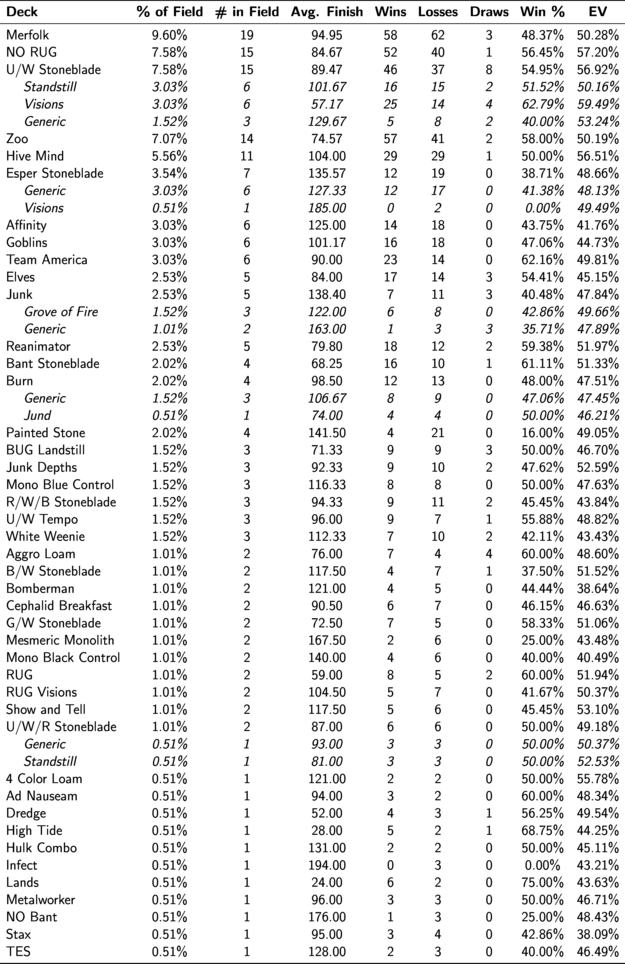
Merfolk was a little more popular in Pittsburgh, creating a wider gap between it and the rest of the top decks, but it was still less popular than usual. Once again, it failed to win even half of its matches.
NO RUG and U/W Stoneblade were tied for second-most popular deck, and each put up a great record. This marks a substantial jump in popularity for NO RUG, which, prior to Seattle, had rarely been even five percent of the field. Of course, with the deck consistently winning more than 56 percent of its matches from tournament to tournament, we can probably expect more and more people to pick it up.
Surprisingly, Zoo performed even better than NO RUG in Pittsburgh. Actually, among the five most-popular decks, Zoo had the best weekend. This is unexpected, even if Zoo did very well in most of the events surrounding GP Providence, because the deck hadn’t seen a great weekend in some time (its win percentages were 49.69% in Baltimore, 50.56% in Cincinnati, and 46.39% in Seattle). It’s interesting to note that Zoo’s EV was about even in Pittsburgh, suggesting that the high win percentage was not the result of a favorable metagame.
Perhaps even more surprising is Hive Mind dropping down to a dead even record. It remained reasonably popular, as we’d expect it to after a result like Seattle. Note the exceptionally high EV, which is quite incongruous with the split record. Did players react to Seattle, and bring a little extra hate for Hive Mind in Pittsburgh?
Esper Stoneblade came in just under the top five, like it did in Cincinnati. This time, it did very poorly. There were more Goblins players than normal, but they weren’t very successful. There was a small resurgence of Team America, and it posted a great record on its way to winning the tournament. Elves did better this time, and Junk did worse. Reanimator did very well, as did Bant Stoneblade, the latter backing up its strong result in Seattle.
B/W Stoneblade was down to two players, and Dredge was down to just one. Both decks had enjoyed periods of much greater popularity in earlier months, but at this point the metagame appeared to have settled a bit, with Merfolk, UW Stoneblade, NO RUG, Zoo, and Hive Mind firmly at the top.
Richmond Legacy Open Breakdown
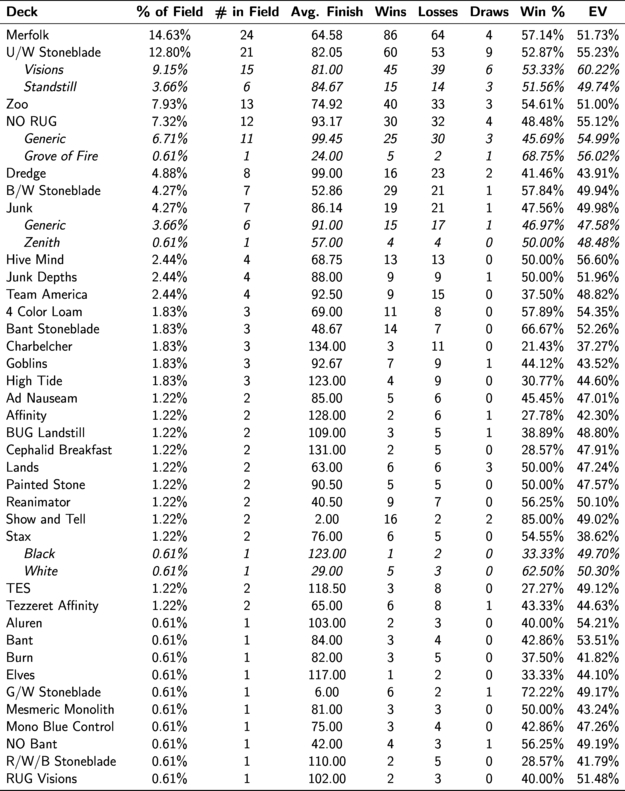
Richmond was noticeably less diverse than the previous tournaments. It looks like all the top decks were even more popular than normal. We might interpret this as a sign that the metagame was coalescing around the “Big Five” even more, if not for Hive Mind barely even showing up, and B/W Stoneblade and Dredge both returning to their former levels of play.
Merfolk certainly doesn’t look out of place at the top of the list, but its being nearly 15% of the field is still striking after the previous two events. Not only that; after a streak of even or worse records, Merfolk was actually one of the best-performing decks in Richmond. Just like Zoo in the previous tournament, however, we can see that Merfolk’s EV was not nearly as high as its win percentage. Whether it was a good idea to play Merfolk in Richmond is debatable, but it does seem doubtful that the deck will cease to be Legacy’s most popular archetype anytime soon.
U/W Stoneblade’s popularity also increased dramatically, to claim a larger portion of the field than any non-Merfolk deck has in a long time. Its win percentage was positive, though lower than in the previous two tournaments. The deck’s EV was actually better than the results, suggesting that it was a good choice for the environment.
Zoo was the third-most popular deck, and in fact made up about the same percentage of the field that it did in both Seattle and Pittsburgh. Even so, the deck was almost five percentage points behind U/W Stoneblade, and barely half as prevalent as Merfolk. Zoo did record another positive win percentage, though, even if its EV was (once again) considerably lower.
NO RUG was also about as popular as before, but its record was terrible. NO RUG didn’t just do worse than it’s ever done before (its previous low was a ridiculously good 56.18%); it actually lost more matches than it won. The deck’s EV was 55.12%, which is actually less than normal for NO RUG, suggesting that metagame changes can account for some of the terrible performance, but its EV was still far better than its actual win percentage. Up to this point, NO RUG had been extremely consistent at putting up amazing win percentages, making this the most surprising result from the tournament.
Below the top four decks, there was a gap of a few percentage points before Dredge. After three tournaments of getting less and less popular, the deck rebounded to almost five percent of the field. Its win percentage, however, was extremely low. B/W Stoneblade returned to being about as popular as it was in Seattle, and it did extremely well, despite an unimpressive EV.
Hive Mind was only played by four people in Richmond, and those players only managed another even record with it. With two mediocre results bracketing a severe drop in popularity, the deck’s overwhelming success in Seattle seemed to be a distant memory after Richmond.
Boston Legacy Open Breakdown
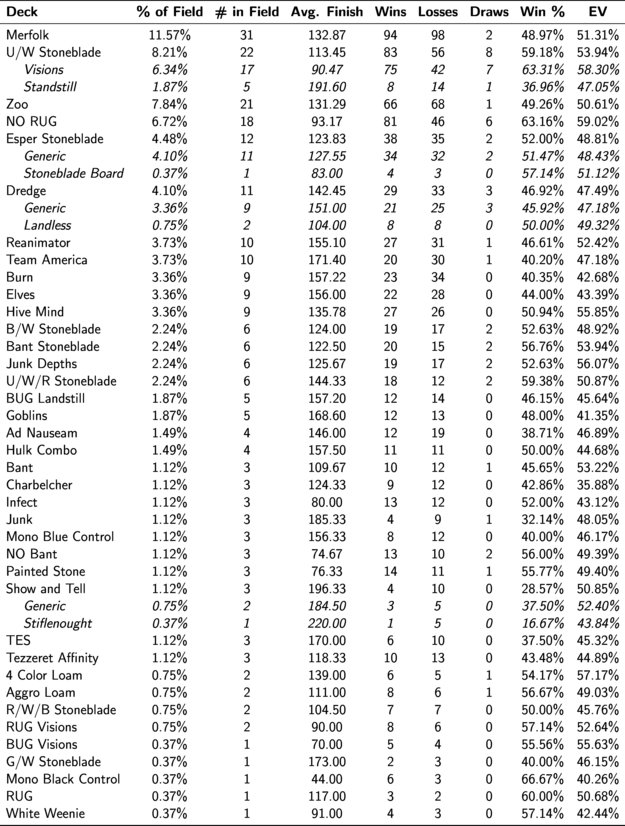
Our top four decks in Boston were exactly the same as our top four in Richmond, and in the same order. This time, there was a bit less of all of them, so some of the other decks have a little more play.
Merfolk’s win percentage went back down along with its popularity, to just below even once again.
U/W Stoneblade, on the other hand, did extremely well. The tournament coverage bears this out, since there were four copies of the deck in the Top 16 (along with three other Stoneblades: one U/W/R, one Esper, and one Bant).
Zoo didn’t do so well this time, winning just under half of its matches. This lines up closer with its EV than the results of the previous events.
NO RUG followed up its worst weekend ever (and its only bad one) with its best weekend ever, winning 63.16% of matches and putting five players into the Top 16. Despite its poor showing in Richmond, the deck still appears to be insanely good.
Esper Stoneblade, which was completely absent in Richmond, was back up to just under five percent in Boston. Its record was slightly positive this time. Dredge was once again a somewhat popular deck, and it once again failed to do well. Reanimator, Team America, Burn, and Elves were all a little more popular than usual, but none of them posted favorable records.
Hive Mind once again was a much smaller portion of the field than it had been in Seattle and Pittsburgh. It won only slightly more than half of its matches this time. It really does appear that players have somehow reacted to the deck’s domination in Seattle and done so very successfully.
B/W Stoneblade was also particularly unpopular, again, though its record was better than even. Junk Depths (which was twice as popular as traditional Junk) was piloted by six people, the same number as B/W, and it was exactly as successful.
Bant Stoneblade and U/W/R Stoneblade, also with six people each, won most of their matches and put one person each into the Top 16. This marks the fourth tournament in a row that Bant Stoneblade posted a solid result, which lends those results much more weight than if they had been isolated incidents. It shouldn’t be surprising if a deck like James Pogues’ from Richmond starts to become more popular.
As you can see, the last month and a half have seen a lot of changes in the Legacy metagame. Some of these may be perfectly ephemeral, stemming from regional variations or other factors unique to a specific tournament, but others will certainly help define the Legacy format for the rest of the 2011 Open season.
One way we can attempt to better understand these metagame shifts is to look further back, to the release of New Phyrexia, and try to identify trends in the metagame breakdown that may be harder to see from tournament to tournament (or even across four of them).
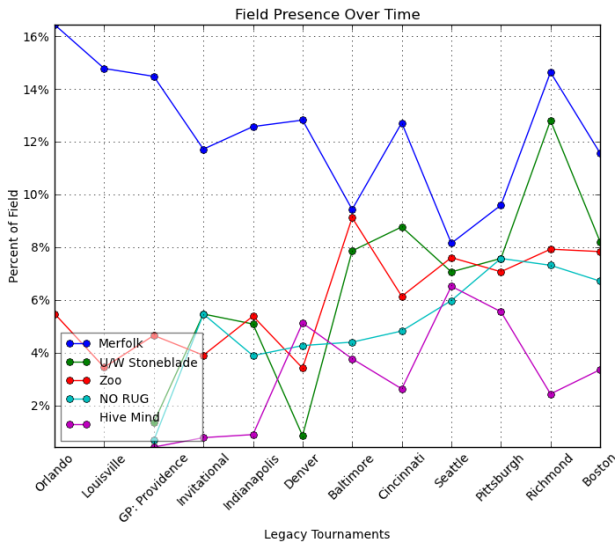
This graph highlights the five most popular decks in Legacy, at least as of the end of July. Those decks are Merfolk, U/W Stoneblade, NO RUG, Zoo, and Hive Mind. Of course, Hive Mind ended up dropping off considerably through August, and that is one of the trends that is clearly visible.
Actually, if you study Hive Mind’s popularity from the beginning, we can make a reasonable attempt to single out potential outliers. You can see how the deck basically came into existence at GP: Providence, and then slowly began ramping up in popularity. There was a spike in Denver, which makes it look as though Hive Mind was in decline in Baltimore and Cincinnati, but the high point in Seattle can easily be interpreted as the peak of an upward popularity trend, fueled by the deck’s considerable success over this time period. The subsequent drop may prove to be part of a downward trend, or variance between tournaments; we really don’t know that, yet.
Merfolk’s numbers are fascinating because they seem to react to the rest of the metagame directly, and more so than the other decks. Notice how Merfolk’s popularity was highest in Orlando, Louisville, and Providence, immediately following New Phyrexia’s release and (practically speaking) prior to the existence of U/W Stoneblade, NO RUG, and Hive Mind. Once those decks began gaining traction, Merfolk started sliding, and you can clearly see that its popularity dove at each event where one or more of the other decks made a corresponding jump. Merfolk’s low point, in Seattle, was low because more players chose to pick up any one of the other decks than ever before.
U/W Stoneblade traces a path easy enough to see. Aside from an inexplicable absence in Denver, the deck seems to have enjoyed a very enthusiastic adoption rate since the Grand Prix, to the extent that it has basically shadowed Merfolk for most of the past two months. The only other deck that has rivaled U/W in popularity has been Zoo, which has only done so sporadically.
Zoo, as one of only two “pre-New Phyrexia” decks that have remained important in Legacy, has had its good and bad days throughout this time period, but seems to be trending upward, overall. Discounting the peak in Baltimore, Zoo was more popular in the last four events than in any of those previous.
And finally, we look at NO RUG, which has arguably been the best-performing deck since the Grand Prix (its total win percentage is 58.29%). Graphed, its popularity forms a beautiful, upward curve, although it almost looks like we should have expected it to jump in Richmond, instead of U/W. Why the growth of NO RUG has been so moderated, while U/W has exploded, is a little baffling, but it still seems clear that Progenitus will be bashing more and more faces in the future.
As usual, we’ll now look at each of the most-played decks in more detail, beginning with the obvious:
Merfolk—10.93% of field, won 50.54% of matches
Example: Josh Crowe, Pittsburgh Open, 7th Place

Merfolk has been struggling lately, even if it has managed to hold onto its position at the head of the metagame. These numbers tell the story clearly; the deck simply has weak matchups against the other top decks, including Hive Mind, which has previously been positive. The only good news here is that Merfolk’s matchup against U/W—which is the next most popular deck, after all—has gotten closer in recent events, after being slightly unfavorable earlier in the summer.
U/W Stoneblade—8.72% of field, won 55.43% of matches
Example: Kurt Speiss, Boston Open, 2nd Place

This chart tells almost the exact opposite story. While U/W’s matchup against Merfolk seems to be slipping a bit, each of its others has improved over the course of these four tournaments. While we’ve said before that the deck’s matchups against Zoo and Hive Mind appeared fairly close, now they are beginning to look quite favorable for U/W. The NO RUG matchup is still hard to call, but it also looks better than it did before.
Zoo—7.62% of field, won 51.90% of matches
Example: Dan Musser, Pittsburgh Open, 2nd Place

Among these decks, Zoo stands out a bit for having such polar matchups. It handily beats Merfolk, splits with NO RUG, and simply loses to U/W and Hive Mind. The U/W result is a little surprising, as that matchup looked closer to even, before, but the Hive Mind matchup has always been a bloodbath. Notice that the four matches Zoo did win against Hive Mind during these tournaments were the first it has ever claimed.
NO RUG—6.88% of field, won 58.74% of matches
Example: Alex Bertoncini, Boston Open, 1st Place

NO RUG has seldom revealed chinks in its armor while rising through the format. In truth, the deck simply seems to lack bad matchups, but the numbers this time may yet point to some vulnerabilities. Most notably, U/W Stoneforge was able to win more matches against NO RUG than it lost, which puts it ahead in that feud by one match, overall. Zoo was also able to hold its own against Progenitus, leaving the overall matchup perfectly even. NO RUG continues to be the bane of Hive Mind, though, and the former’s rise in popularity is almost certainly a factor in the latter’s drop in success.
Hive Mind—4.42% of field, won 56.19% of matches
Example: Ben Swartz, Seattle Open, 1st Place

Finally, we’ve been given enough information to examine Hive Mind in detail. Even though deck failed to show up in significant numbers after Pittsburgh, the addition of the data collected in the last month and a half has roughly doubled the number of matches recorded between Hive Mind and the other top decks.
Like Zoo, Legacy’s only top-tier combo deck also has strikingly disparate matchup percentages, although the overall results are less so than the recent ones. Specifically, the Merfolk and U/W matchups are probably closer to even than they appear when looking at just these four events, although it is those recent results that pull them toward 50%. Previously, the Merfolk matchup had appeared much worse, and the U/W much better, but both inconsistencies may be explained by how little data we had before now.
The Zoo and NO RUG matchups look to remain much as they have been, though, the former being almost unbelievably positive while the other is negative, if not nearly as severe.
Hive Mind’s total win percentage is the best of the five, thanks to its domination in Seattle, and any deck that alternates between weekends like that and “merely” even ones is bound to remain a contender in the future.
Trying to digest all of this information at once is a bit difficult. Legacy definitely looks different now than it did at the end of July, just as it probably will at the end of September (the Banned and Restricted announcement notwithstanding). Merfolk is still there, but U/W Stoneforge is right behind it, and NO RUG has also claimed its spot next to Zoo among the most played decks. Hive Mind may be in recession, or it may not be; it’s anyone’s guess how much of it will show up in Atlanta, or how well it will do there.
If the decks to beat right now are Merfolk and U/W, then the deck to play is certainly NO RUG. Nothing else comes close to matching it for consistency and success. We’ve said that before, which means it’s been true for several months, now, but nothing is really poised to knock the deck over, yet. Natural Order is no Survival of the Fittest, but it’s probably about as good as anything can be without deserving a true comparison.
U/W is a reasonable weapon of choice, maintaining a positive win percentage with consistency to rival NO RUG, although that win percentage is always lower, and boasting a reasonable matchup against the other deck, to boot. With its popularity soaring, though, anyone looking at this deck should be prepared for the mirror, and it appears that the once-strong Merfolk matchup may be worsening.
Since this is Legacy, there are plenty of other decks to consider playing, but few of them really distinguished themselves in the wake of the popular choices. One of those that did is Bant Stoneforge, which had very good win percentages in all four events. That is probably worth something, despite the lack of data available for the deck, and the lack of homogeneity between examples of the archetype.
So, what will triumph in Atlanta? Will NO RUG improve upon its sacking of Boston? Or will Hive Mind return with a vengeance? Whatever happens, we’ll be eager to analyze the results. Good luck to all of you attending the event yourselves, and we hope you’ll tune in next time!
Alix Hatfield
Jesse Hatfield
